1995 CADILLAC SEVILLE check engine
[x] Cancel search: check enginePage 164 of 410
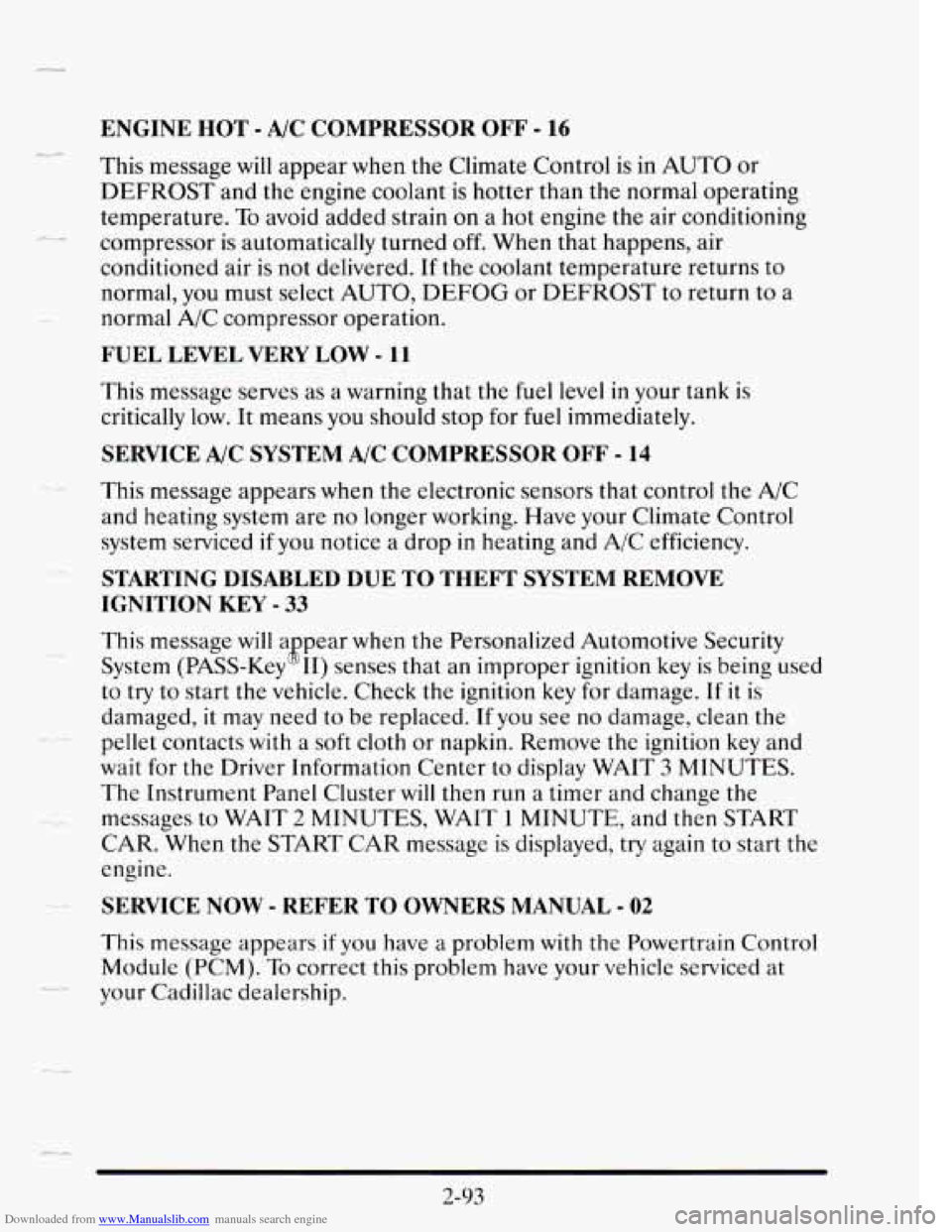
Downloaded from www.Manualslib.com manuals search engine ENGINE HOT - A/C COMPRESSOR OFF - 16
-_ ..
This message will appear when the Climate Control is in AUTO or
DEFROST and the engine coolant is hotter than the normal operating
temperature. To avoid added strain on a hot engine the air conditioning
compressor is automatically turned off. When that happens, air
conditioned air is not delivered.
If the coolant temperature returns to
normal, you must select AUTO,
DEFOG or DEFROST to return to a
normal A/C compressor operation.
I_ -
FUEL LEVEL VERY LOW - 11
This message serves as a warning that the fuel level in your tank is
critically low. It means you should stop for fuel immediately.
SERVICE A/C SYSTEM A/C COMPRESSOR OFF - 14
- This message appears when the electronic sensors that control the A/C
and heating system are
no longer working. Have your Climate Control
system serviced
if you notice a drop in heating and A/C efficiency.
STARTING DISABLED DUE TO THEFT SYSTEM REMOVE
IGNITION
KEY - 33
This message will a pear when the Personalized Automotive Security
System (PASS-Key
8 11) senses that an improper ignition key is being used
to
try to start the vehicle. Check the ignition key for damage. If it is
damaged,
it may need to be replaced. If you see no damage, clean the
~ pellet contacts with a soft cloth or napkin. Remove the ignition key and
wait for the Driver Information Center
to display WAIT 3 MINUTES.
The Instrument Panel Cluster
will then run a timer and change the
messages to WAIT
2 MINUTES, WAIT 1 MINUTE, and then START
CAR. When the START CAR message is displayed,
try again to start the
engine.
SERVICE NOW - REFER TO OWNERS MANUAL - 02
This message appears if you have a problem with the Powertrain Control
Module (PCM). To correct this problem have your vehicle serviced at
your Cadillac dealership.
---
2-93
Page 165 of 410
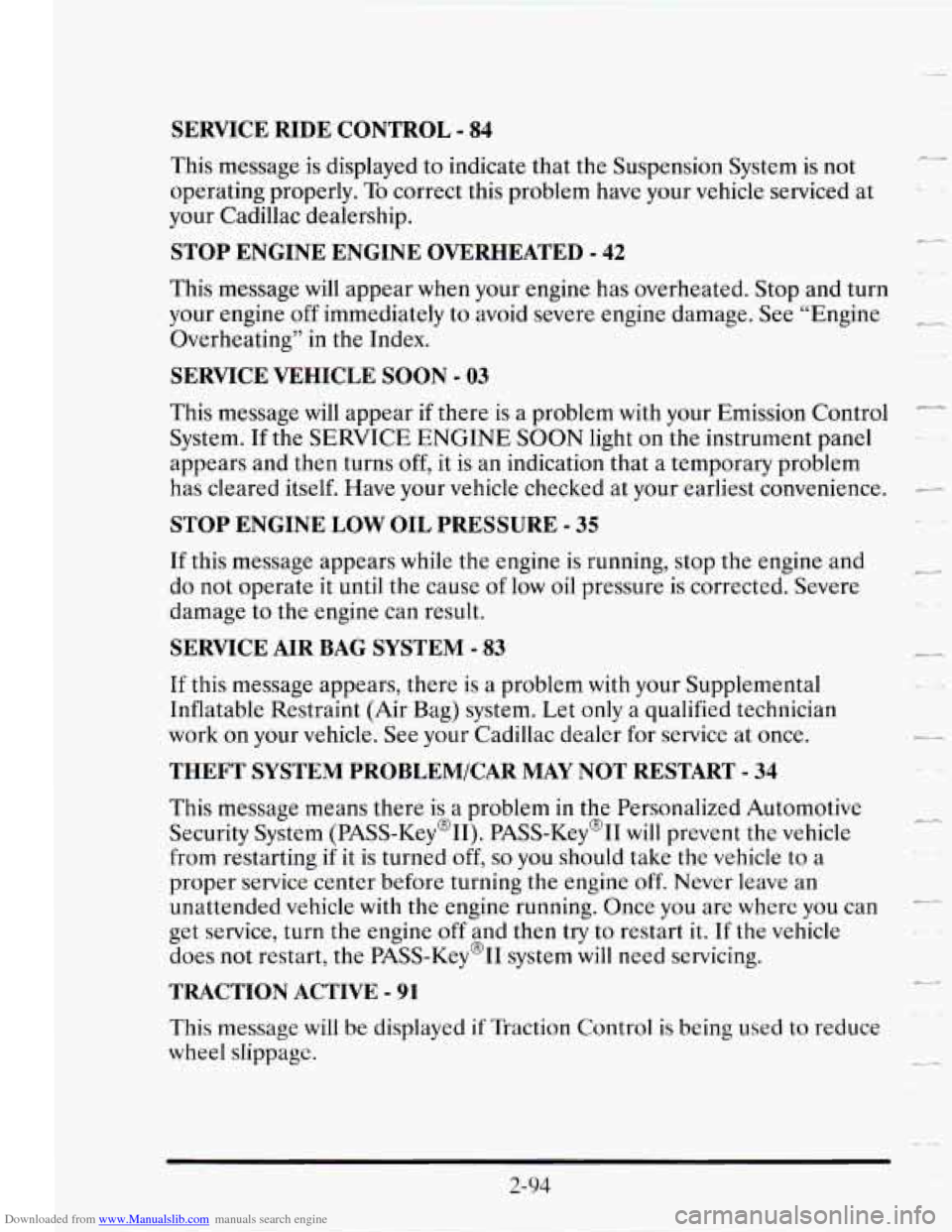
Downloaded from www.Manualslib.com manuals search engine SERVICE RIDE CONTROL - 84
This message is displayed to indicate that the Suspension System
is not
operating properly.
To correct this problem have your vehicle serviced at
your Cadillac dealership.
CI
c d’
STOP ENGINE ENGINE OVERHEATED - 42
-
This message will appear when your engine has overheated. Stop and turn
your engine off immediately to avoid severe engine damage. See “Engine
__
Overheating” in the Index.
-2
SERVICE VEHICLE SOON - 03
’-
This message will appear if there is a problem with your Emission Control
System. If the
SERVICE ENGINE SOON light on the instrument panel
appears and then turns off, it is an indication that a temporary problem
has cleared itself.
Have your vehicle checked at your earliest convenience. -
-
STOP ENGINE LOW OIL PRESSURE - 35
If this message appears while the engine is running, stop the engine and
do not operate it until the cause of
low oil pressure is corrected. Severe
damage to the engine can result.
SERVICE AIR BAG SYSTEM - 83
If this message appears, there is a problem with your Supplemental
Inflatable Restraint (Air Bag) system. Let
only a qualified technician
work
on your vehicle. See your Cadillac dealer for service at once.
THEFT SYSTEM PROBLEM/CAR MAY NOT RESTART - 34
This message means there is a problem in the Personalized Automotive
Security System (PASS-Key%). PASS-Key@II
will prevent the vehicle
from restarting
if it is turned off, so you should take the vehicle to a
proper service center before turning the engine off. Never leave an
unattended vehicle with the engine running. Once you are where you can
get service, turn the engine
off and then try to restart it. If the vehicle
does not restart, the PASS-Key@II system
will need servicing.
TRACTION ACTIVE - 91
This message will be displayed if Traction Control is being used to reduce
wheel slippage.
c_
c
2-94
Page 168 of 410
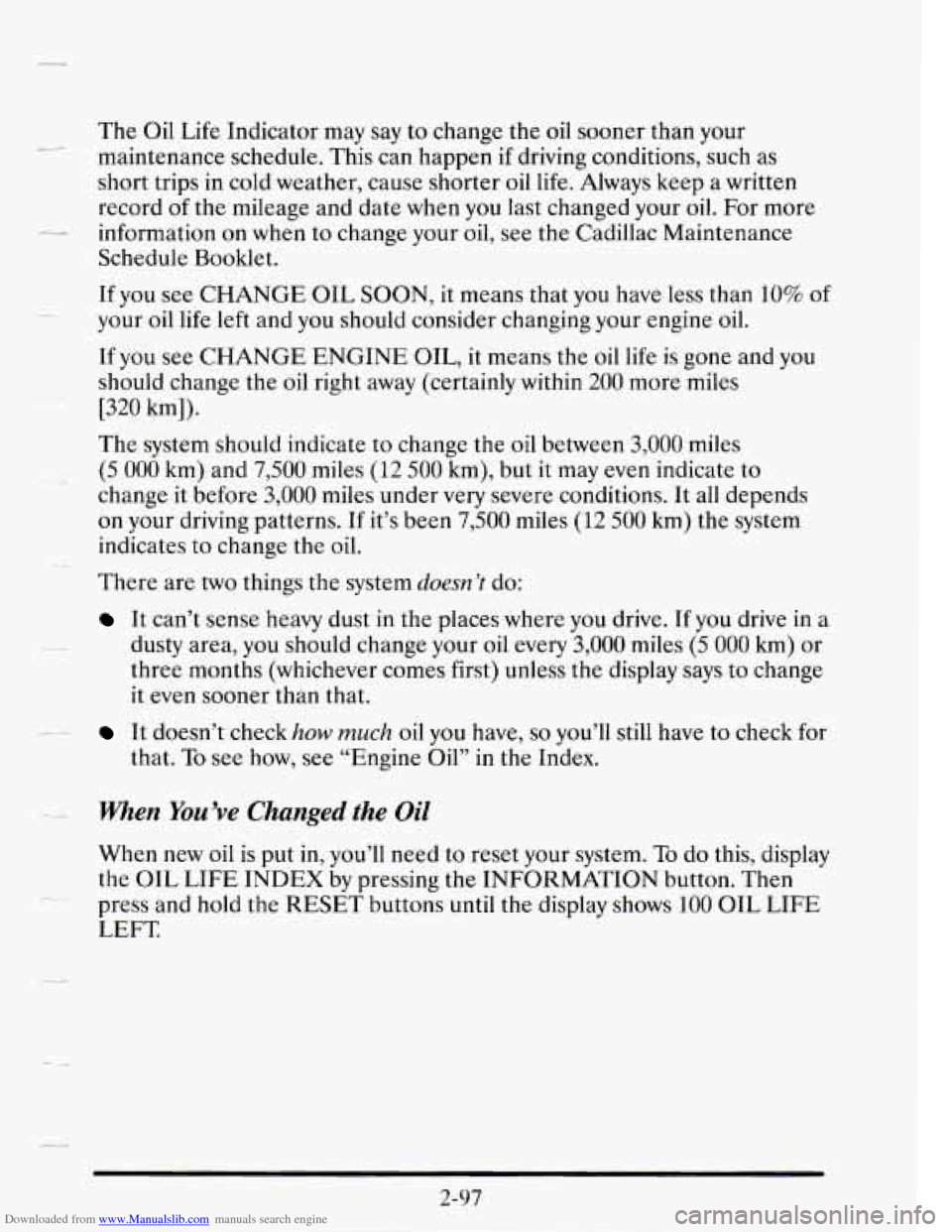
Downloaded from www.Manualslib.com manuals search engine The Oil Life Indicator may say to change the oil sooner than your
maintenance schedule. This can happen
if driving conditions, such as
short trips in cold weather, cause shorter oil life. Always keep a written
record
of the mileage and date when you last changed your oil. For more
Schedule Booklet.
.r-c
- information on when to change your oil, see the Cadillac Maintenance
11 you see CHANGE OIL SOON, it means that you have less than 10% of
If you see CHANGE ENGINE OIL, it means the oil life is gone and you
should change the oil right away (certainly within 200 more miles
[320 km]).
The system should indicate to change the oil between
3,000 miles
(5 000 km) and 7,500 miles (12 500 km), but it may even indicate to
change
it before 3,000 miles under very severe conditions. It all depends
on your driving patterns. If it’s been 7,500 miles (12 500 km) the system
indicates
to change the oil.
-~ your oil life left and you should consider changing your engine oil.
There are two things the system
doesn’t do:
It can’t sense heavy dust in the places where you drive. If you drive in a
dusty area, you should change your
oil every 3,000 miles (5 000 km) or
three months (whichever comes first) unless the display says to change
it even sooner than that.
-- It doesn’t check how much oil you have, so you’ll still have to check for
that.
To see how, see “Engine Oil” in the Index.
-- When You’ve Changed the Oil
When new oil is put in, you’ll need to reset your system. To do this, display
the
OIL LIFE INDEX by pressing the INFORMATION button. Then
LEFT
-- press and hold the RESET buttons until the display shows 100 OIL LIFE
2-97
Page 174 of 410
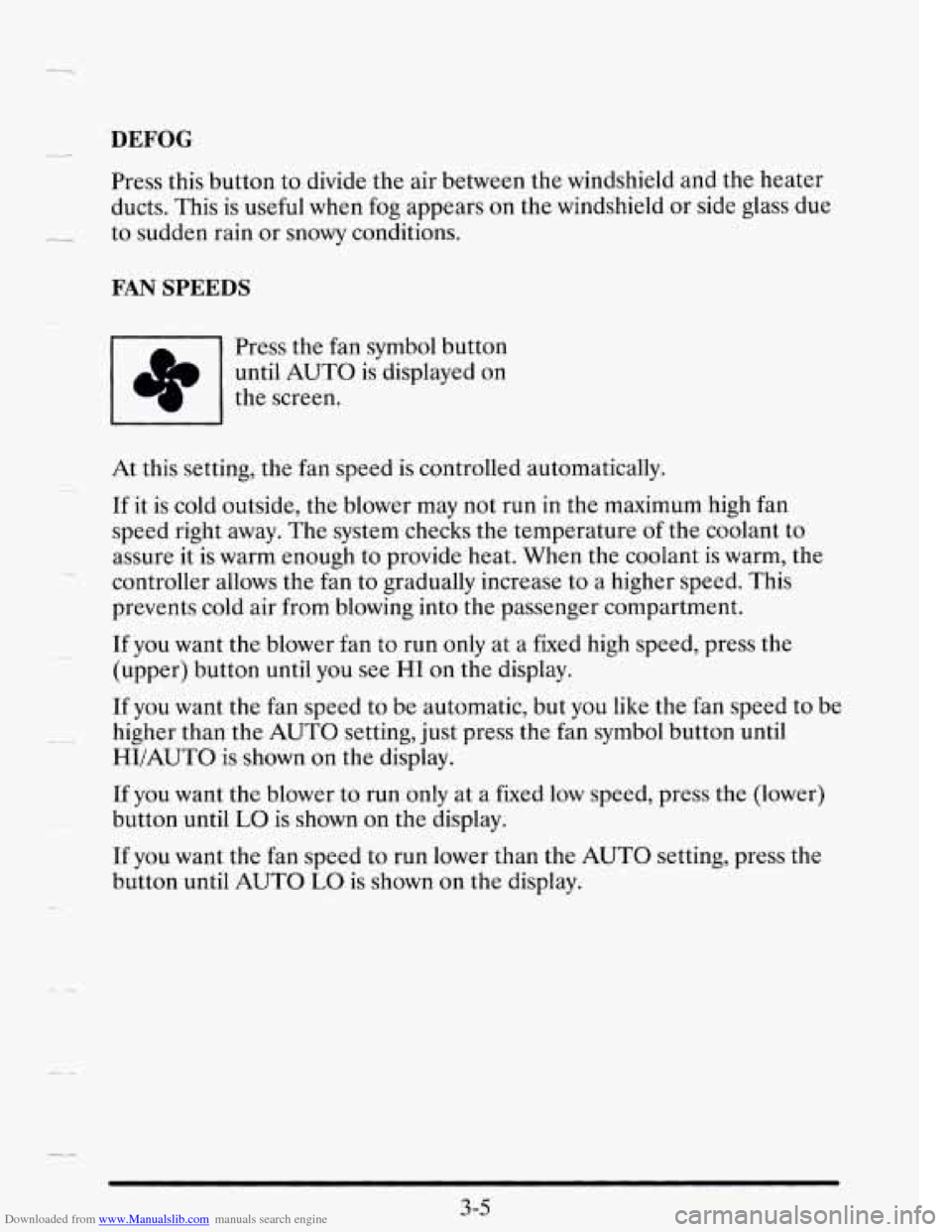
Downloaded from www.Manualslib.com manuals search engine DEFOG
Press this button to divide the air between the windshield and the heater
ducts. This is useful when fog appears on the windshield or side glass due
to sudden rain or snowy conditions.
FAN SPEEDS
Press the fan symbol button
until AUTO is displayed on
At this setting, the fan speed is controlled automatically.
If it is cold outside, the blower may not run in the maximum high fan
speed right away. The system checks the temperature of the coolant to
assure it is warm enough to provide heat. When the coolant is warm, the
controller allows the fan to gradually increase to a higher speed. This
prevents cold air from blowing into the passenger compartment.
If you want the blower fan to run only at a fixed high speed, press the
(upper) button until you see
HI on the display.
If you want the fan speed to be automatic, but you like the fan speed to be
higher than the AUTO setting, just press the fan symbol button until
HI/AUTO is shown on the display.
If
you want the blower to run only at a fixed low speed, press the (lower)
button until
LO is shown on the display.
If you want the fan speed to run lower than the AUTO setting, press the
button until AUTO
LO is shown on the display.
3-5
Page 186 of 410
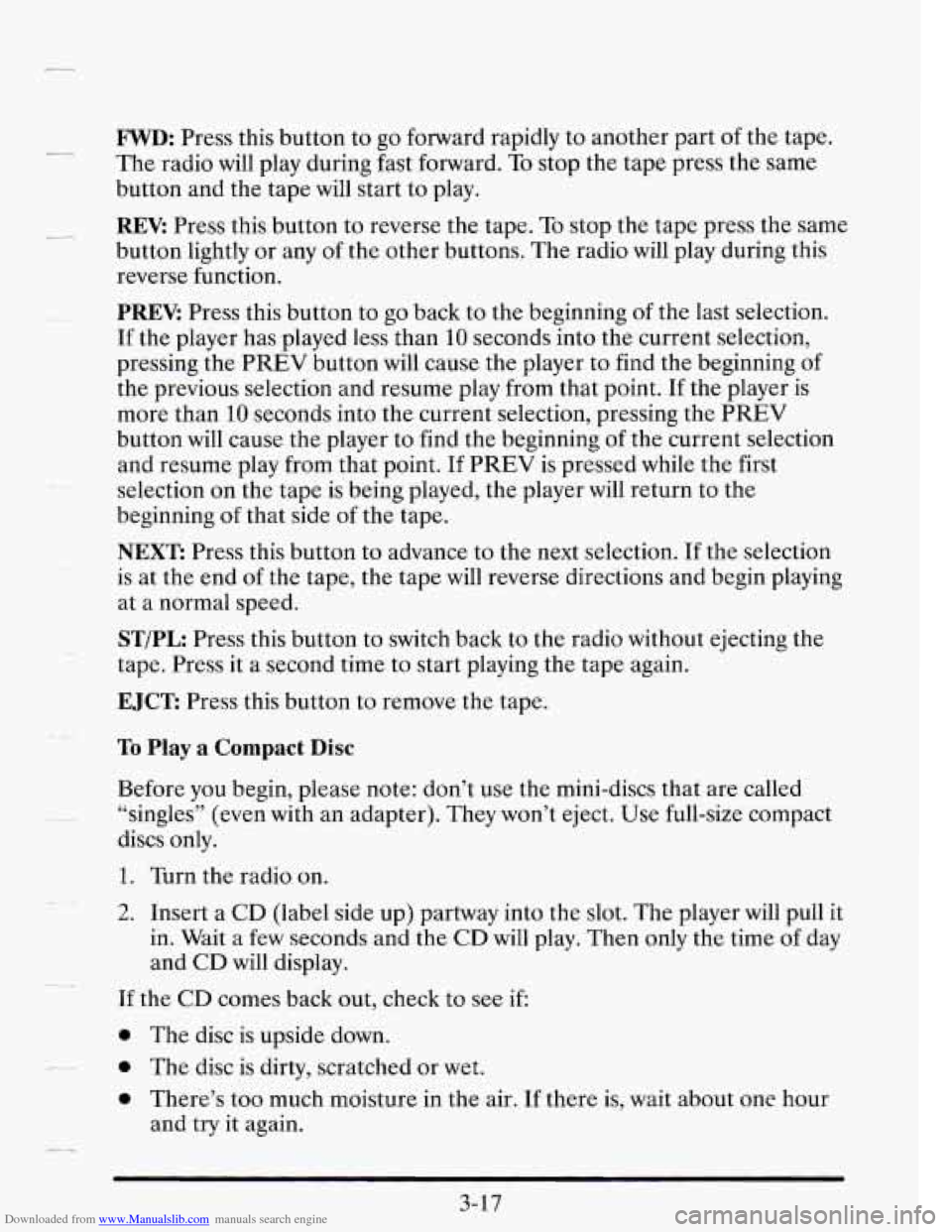
Downloaded from www.Manualslib.com manuals search engine FWD: Press this button to go forward rapidly to another part of the tape.
The radio will play during fast forward.
To stop the tape press the same
button and the tape will start to play.
REV: Press this button to reverse the tape. To stop the tape press the same
button lightly or any
of the other buttons. The radio will play during this
reverse function.
PREV: Press this button to go back to the beginning of the last selection.
If the player has played less than
10 seconds into the current selection,
pressing the PREV button will cause the player to find the beginning of
the previous selection and resume play from that point. If the player is
more than
10 seconds into the current selection, pressing the PREV
button will cause the player to find the beginning of the current selection
and resume play from that point.
If PREV is pressed while the first
selection on the tape is being played, the player will return to the
beginning
of that side of the tape.
NEXT: Press this button to advance to the next selection. If the selection
is at the end of the tape, the tape will reverse directions and begin playing
at a normal speed.
ST/PL Press this button to switch back to the radio without ejecting the
tape. Press it
a second time to start playing the tape again.
EJCT Press this button to remove the tape.
To Play a Compact Disc
Before you begin, please note: don’t use the mini-discs that are called
“singles” (even with an adapter). They won’t eject. Use full-size compact
discs only.
1. Turn the radio on.
2. Insert a CD (label side up) partway into the slot. The player will pull it
in.
Wait a few seconds and the CD will play. Then only the time of day
and
CD will display.
If the
CD comes back out, check to see if
0 The disc is upside down.
0 The disc is dirty, scratched or wet.
0 There’s too much moisture in the air. If there is, wait about one hour
and
try it again.
Page 188 of 410
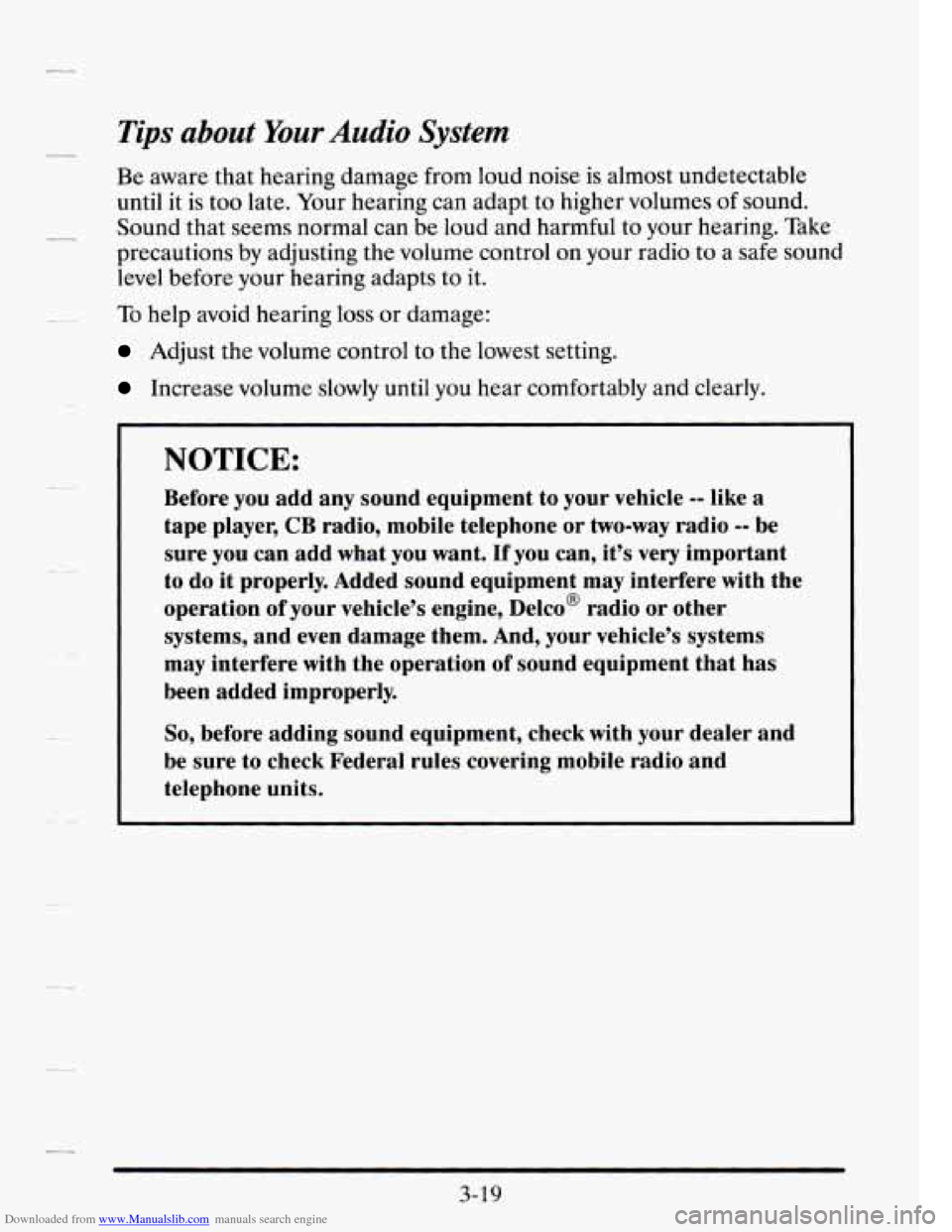
Downloaded from www.Manualslib.com manuals search engine c --
Tips about Your Audio System
Be aware that hearing damage from loud noise is almost undetectable
until it is too late. Your hearing can adapt to higher volumes
of sound.
Sound that seems normal can be loud and harmful to your hearing. Take
precautions
by adjusting the volume control on your radio to a safe sound
level before your hearing adapts to it.
To help avoid hearing loss or damage:
Adjust the volume control to the lowest setting.
Increase volume slowly until you hear comfortably and clearly.
.. - - --
NOTICE:
Before you add any sound equipment to your vehicle -- like a
tape player, CB radio, mobile telephone or two-way radio -- be
sure you can add what you want. If you can, it’s very important
to do
it properly. Added sound equipment may interfere with the
operation of your vehicle’s engine, Delco@ radio
or other
systems, and even damage them. And, your vehicle’s systems
may interfere with the operation of sound equipment that has
been added improperly.
So, before adding sound equipment, check with your dealer and
be sure to check Federal rules covering mobile radio and
telephone units.
3-19
Page 207 of 410
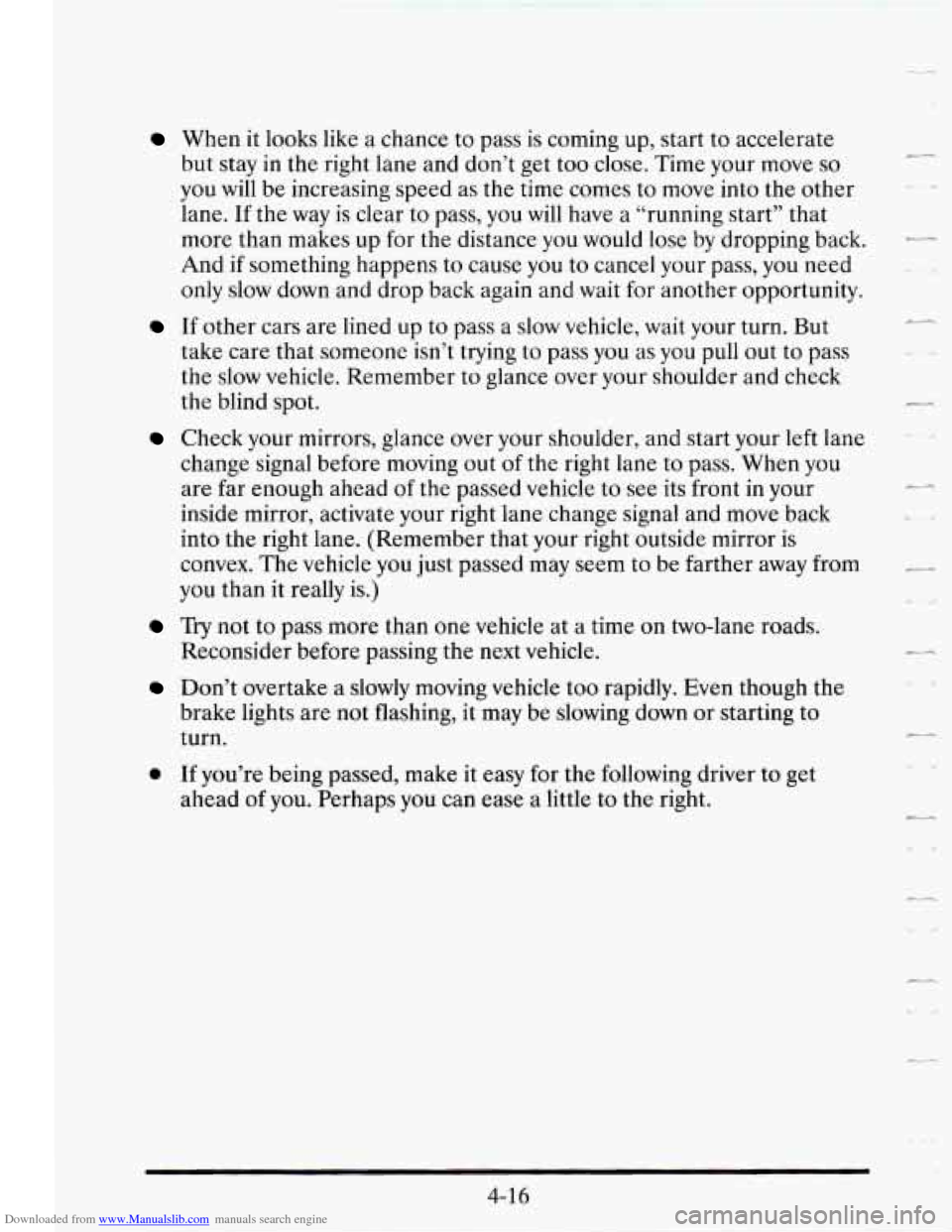
Downloaded from www.Manualslib.com manuals search engine When it looks like a chance to pass is coming up, start to accelerate
but stay in the right lane and don’t get too close. Time your move
so
you will be increasing speed as the time comes to move into the other
lane. If the way is clear to pass, you
will have a “running start” that
more than makes up
for the distance you would lose by dropping back.
And if something happens
to cause you to cancel your pass, you need
only slow down and drop back again and wait for another opportunity.
take care that someone isn’t trying
to pass you as you pull out to pass
the slow vehicle. Remember
to glance over your shoulder and check
the blind spot.
Check your mirrors, glance over your shoulder, and start your left lane
change signal before moving
out of the right lane to pass. When you
are far enough ahead
of the passed vehicle to see its front in your
inside mirror, activate your right lane change signal and move back
into the right lane. (Remember that your right outside mirror is
convex. The vehicle you just passed may seem to be farther away from
you than it really is.)
Reconsider before passing the next vehicle.
If other cars are lined up to pass a slow vehicle, wait your turn. But
Try not to pass more than one vehicle at a time on two-lane roads.
Don’t overtake a slowly moving vehicle too rapidly. Even though the
brake lights are not flashing, it may be slowing down or starting to
turn.
0 If you’re being passed, make it easy for the following driver to get
ahead
of you. Perhaps you can ease a little to the right.
4-1 6
-4
.-
--J
Page 211 of 410
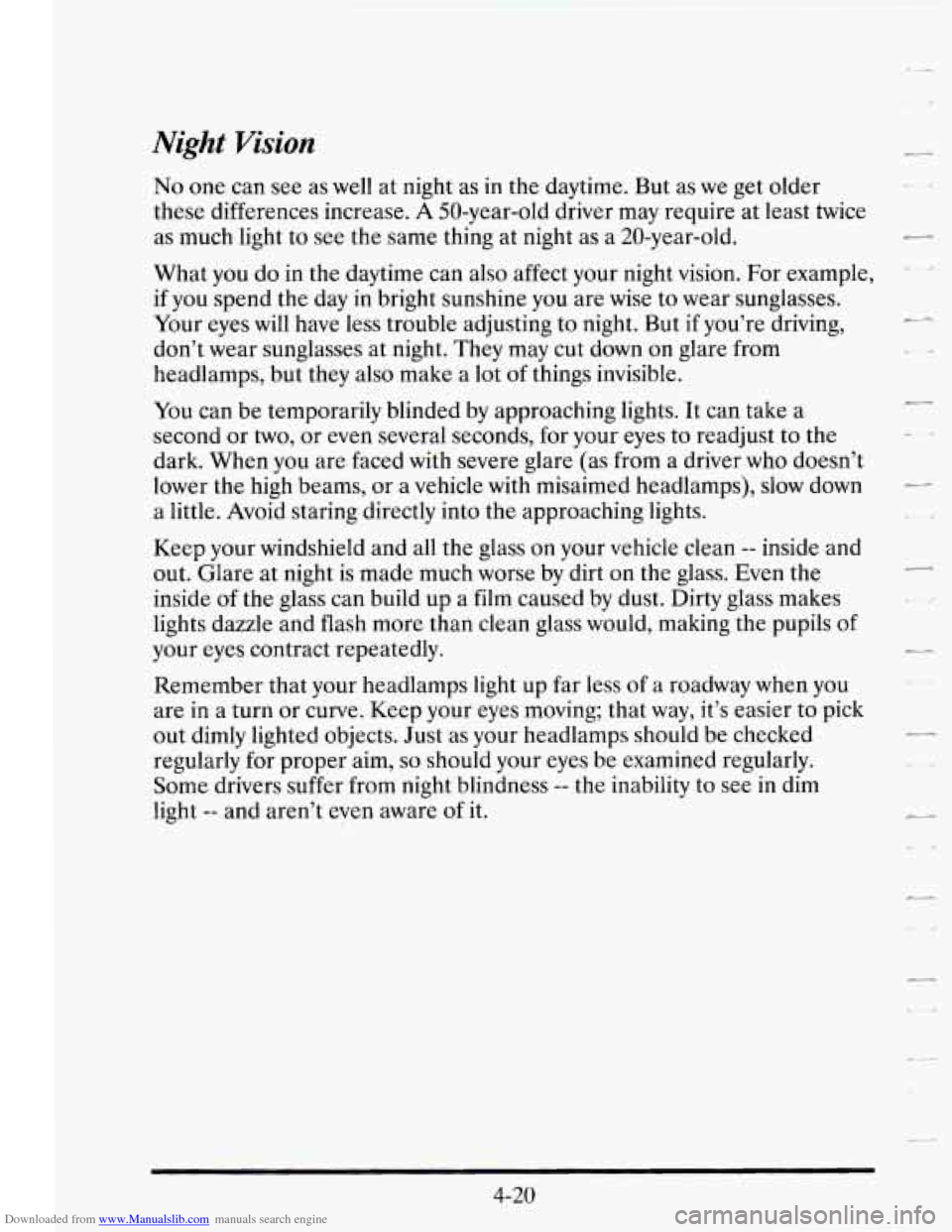
Downloaded from www.Manualslib.com manuals search engine Night Vision
No one can see as well at night as in the daytime. But as we get older
these differences increase.
A 50-year-old driver may require at least twice
as much light to see the same thing at night as a 20-year-old.
-
CI
b
What you do in the daytime can also affect your night vision. For example,
if you spend the day in bright sunshine you are wise to wear sunglasses.
Your eyes
will have less trouble adjusting to night. But if you’re driving,
don’t wear sunglasses at night. They may cut down
on glare from
headlamps, but they also make
a lot of things invisible.
You can be temporarily blinded by approaching lights. It can take a
second or
two, or even several seconds, for your eyes to readjust to the
dark. When
you are faced with severe glare (as from a driver who doesn’t
lower the high beams, or a vehicle with misaimed headlamps), slow down
c-
a little. Avoid staring directly into the approaching lights. ..
Keep your windshield and all the glass on your vehicle clean -- inside and
out. Glare at night is made much worse by dirt on the glass. Even the
.--
inside of the glass can build up a film caused by dust. Dirty glass makes
lights dazzle and flash more than clean glass would, making the pupils
of
your eyes contract repeatedly.
Remember that your headlamps light up far less
of a roadway when you
are in a turn or curve. Keep your eyes moving; that way, it’s easier to pick
out dimly lighted objects. Just as your headlamps should be checked
regularly for proper aim,
so should your eyes be examined regularly.
Some drivers suffer from night blindness
-- the inability to see in dim
light
-- and aren’t even aware of it.
4-20
-
).- J